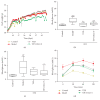The Aqueous Extract of Gynura divaricata (L.) DC. Improves Glucose and Lipid Metabolism and Ameliorates Type 2 Diabetes Mellitus
- PMID: 29599810
- PMCID: PMC5828177
- DOI: 10.1155/2018/8686297
The Aqueous Extract of Gynura divaricata (L.) DC. Improves Glucose and Lipid Metabolism and Ameliorates Type 2 Diabetes Mellitus
Abstract
Type 2 diabetes mellitus (T2DM) is a chronic disease characterized by hyperglycemia and dyslipidemia caused by impaired insulin secretion and resistance of the peripheral tissues. A major pathogenesis of T2DM is obesity-associated insulin resistance. Gynura divaricata (L.) DC. (GD) is a natural plant and has been reported to have numerous health-promoting effects on both animals and humans. In this study, we aimed to elucidate the regulatory mechanism of GD improving glucose and lipid metabolism in an obesity animal model induced by high-fat and high-sugar diet in combination with low dose of streptozocin and an insulin-resistant HepG2 cell model induced by dexamethasone. The study showed that the water extract of GD (GD extract A) could significantly reduce fasting serum glucose, reverse dyslipidemia and pancreatic damage, and regulate the body weight of mice. We also found that GD extract A had low toxicity in vivo and in vitro. Furthermore, GD extract A may increase glucose consumption in insulin-resistant HepG2 cells, markedly inhibit NF-κB activation, and decrease the impairment in signaling molecules of insulin pathway, such as IRS-1, AKT, and GLUT1. Overall, the results indicate that GD extract A is a promising candidate for the prevention and treatment of T2DM.
Figures







Similar articles
-
Hypoglycemic activities of lyophilized powder of Gynura divaricata by improving antioxidant potential and insulin signaling in type 2 diabetic mice.Food Nutr Res. 2015 Dec 28;59:29652. doi: 10.3402/fnr.v59.29652. eCollection 2015. Food Nutr Res. 2015. PMID: 26715102 Free PMC article.
-
Gynura divaricata rich in 3, 5-/4, 5-dicaffeoylquinic acid and chlorogenic acid reduces islet cell apoptosis and improves pancreatic function in type 2 diabetic mice.Nutr Metab (Lond). 2018 Oct 10;15:73. doi: 10.1186/s12986-018-0310-y. eCollection 2018. Nutr Metab (Lond). 2018. PMID: 30337946 Free PMC article.
-
Gynura divaricata ameliorates hepatic insulin resistance by modulating insulin signalling, maintaining glycolipid homeostasis and reducing inflammation in type 2 diabetic mice.Toxicol Res (Camb). 2019 Sep 27;8(6):928-938. doi: 10.1039/c9tx00191c. eCollection 2019 Nov 1. Toxicol Res (Camb). 2019. PMID: 32206302 Free PMC article.
-
Metabolism and insulin signaling in common metabolic disorders and inherited insulin resistance.Dan Med J. 2014 Jul;61(7):B4890. Dan Med J. 2014. PMID: 25123125 Review.
-
Boswellic extracts and 11-keto-ß-boswellic acids prevent type 1 and type 2 diabetes mellitus by suppressing the expression of proinflammatory cytokines.Phytomedicine. 2019 Oct;63:153002. doi: 10.1016/j.phymed.2019.153002. Epub 2019 Jun 28. Phytomedicine. 2019. PMID: 31301539 Review.
Cited by
-
Maca extracts regulate glucose and lipid metabolism in insulin-resistant HepG2 cells via the PI3K/AKT signalling pathway.Food Sci Nutr. 2021 Mar 29;9(6):2894-2907. doi: 10.1002/fsn3.2246. eCollection 2021 Jun. Food Sci Nutr. 2021. PMID: 34136157 Free PMC article.
-
Gynura divaricata Water Extract Presented the Possibility to Enhance Neuronal Regeneration.Evid Based Complement Alternat Med. 2021 Feb 17;2021:8818618. doi: 10.1155/2021/8818618. eCollection 2021. Evid Based Complement Alternat Med. 2021. PMID: 33680064 Free PMC article.
-
High-Intensity Interval Training Restores Glycolipid Metabolism and Mitochondrial Function in Skeletal Muscle of Mice With Type 2 Diabetes.Front Endocrinol (Lausanne). 2020 Aug 14;11:561. doi: 10.3389/fendo.2020.00561. eCollection 2020. Front Endocrinol (Lausanne). 2020. PMID: 32922365 Free PMC article.
-
Germacrone cooperates with dexmedetomidine to alleviate high-fat diet-induced type 2 diabetes mellitus via upregulating AMPKα1 expression.Exp Ther Med. 2019 Nov;18(5):3514-3524. doi: 10.3892/etm.2019.7990. Epub 2019 Sep 9. Exp Ther Med. 2019. Retraction in: Exp Ther Med. 2024 Jan 29;27(3):119. doi: 10.3892/etm.2024.12406. PMID: 31602228 Free PMC article. Retracted.
-
Intervention of Gastrodin in Type 2 Diabetes Mellitus and Its Mechanism.Front Pharmacol. 2021 Sep 16;12:710722. doi: 10.3389/fphar.2021.710722. eCollection 2021. Front Pharmacol. 2021. PMID: 34603025 Free PMC article.
References
LinkOut - more resources
Full Text Sources
Other Literature Sources
Miscellaneous

